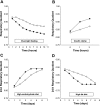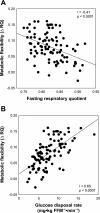Metabolic flexibility and insulin resistance
- PMID: 18765680
- PMCID: PMC2584808
- DOI: 10.1152/ajpendo.90558.2008
Metabolic flexibility and insulin resistance
Abstract
Metabolic flexibility is the capacity for the organism to adapt fuel oxidation to fuel availability. The inability to modify fuel oxidation in response to changes in nutrient availability has been implicated in the accumulation of intramyocellular lipid and insulin resistance. The metabolic flexibility assessed by the ability to switch from fat to carbohydrate oxidation is usually impaired during a hyperinsulinemic clamp in insulin-resistant subjects; however, this "metabolic inflexibility" is mostly the consequence of impaired cellular glucose uptake. Indeed, after controlling for insulin-stimulated glucose disposal rate (amount of glucose available for oxidation), metabolic flexibility is not altered in obesity regardless of the presence of type 2 diabetes. To understand how intramyocellular lipids accumulate and cause insulin resistance, the assessment of metabolic flexibility to high-fat diets is more relevant than metabolic flexibility during a hyperinsulinemic clamp. An impaired capacity to upregulate muscle lipid oxidation in the face of high lipid supply may lead to increased muscle fat accumulation and insulin resistance. Surprisingly, very few studies have investigated the response to high-fat diets. In this review, we discuss the role of glucose disposal rate, adipose tissue lipid storage, and mitochondrial function on metabolic flexibility. Additionally, we emphasize the bias of using the change in respiratory quotient to calculate metabolic flexibility and propose novel approaches to assess metabolic flexibility. On the basis of current evidence, one cannot conclude that impaired metabolic flexibility is responsible for the accumulation of intramyocellular lipid and insulin resistance. We propose to study metabolic flexibility in response to high-fat diets in individuals having contrasting degree of insulin sensitivity and/or mitochondrial characteristics.
Figures



References
-
- Abbott WG, Howard BV, Christin L, Freymond D, Lillioja S, Boyce VL, Anderson TE, Bogardus C, Ravussin E. Short-term energy balance: relationship with protein, carbohydrate, and fat balances. Am J Physiol Endocrinol Metab 255: E332–E337, 1988. - PubMed
-
- Bachmann OP, Dahl DB, Brechtel K, Machann J, Haap M, Maier T, Loviscach M, Stumvoll M, Claussen CD, Schick F, Haring HU, Jacob S. Effects of intravenous and dietary lipid challenge on intramyocellular lipid content and the relation with insulin sensitivity in humans. Diabetes 50: 2579–2584, 2001. - PubMed
-
- Blaak EE, Hul G, Verdich C, Stich V, Martinez A, Petersen M, Feskens EF, Patel K, Oppert JM, Barbe P, Toubro S, Anderson I, Polak J, Astrup A, Macdonald IA, Langin D, Holst C, Sorensen TI, Saris WH. Fat oxidation before and after a high fat load in the obese insulin-resistant state. J Clin Endocrinol Metab 91: 1462–1469, 2006. - PubMed
-
- Black AE, Prentice AM, Coward WA. Use of food quotients to predict respiratory quotients for the doubly-labelled water method of measuring energy expenditure. Hum Nutr Clin Nutr 40: 381–391, 1986. - PubMed
Publication types
MeSH terms
Grants and funding
LinkOut - more resources
Full Text Sources
Other Literature Sources

